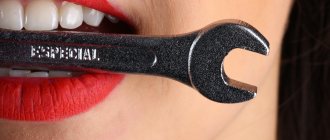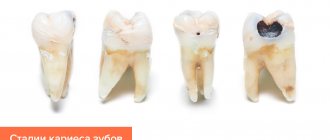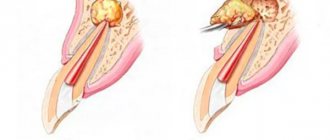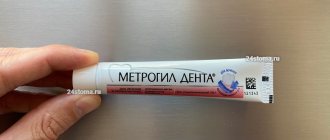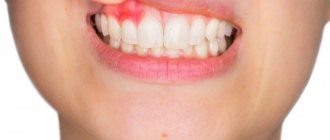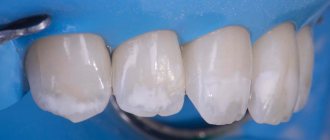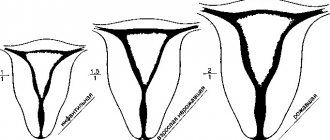What is plaque?
These are non-mineralized deposits consisting of food debris, bacteria, their metabolic products, and saliva. They form on fissures, interdental spaces, contact surfaces, and peri-gingival edges of the tooth. Occurs at any age. Plaque removal is possible at home; coarse deposits are removed in a dental clinic.
Stages of defeat:
- Thin film formation;
- Growth of microorganisms;
- Plaque formation;
- Activation of bacteria leading to demineralization of enamel;
- Lack of oxygen and microelements to the tooth due to plaque closure;
- Evolution of soft plaque in stone;
- Tooth decay.
The rate of development of pathological changes depends on the quality of hygiene procedures, the anatomical structure of the jaws, the method of cleaning, the presence of orthodontic structures, food preferences, concomitant diseases, and bad habits.
Plaque is not washed off by liquids, since it is covered with a film on the outside, but is partially removed during eating. 2-3 hours after removal it is re-formed.
What kind of raid is there?
Dark enamel
The main risk factors for the formation of dark-colored deposits:
- Dysbacteriosis in childhood;
- Hypoplasia of teeth, often of a congenital nature, in children;
- Smoking, consumption of coloring products;
- Deficiency of salivation;
- Disorders of calcium, vitamin D, and phosphorus metabolism.
There is no way to get rid of this problem at home. Increasing the intensity of cleaning will only worsen the situation. It is necessary to eliminate the original cause. Adults are often offered cosmetic correction with veneers.
Black plaque on teeth
The formation of black deposits in childhood is caused by problems with the digestive system, helminthic infestations or fungal infection of the oral cavity.
In adults, risk factors are:
- Alcohol abuse, smoking, drug addiction;
- Long-term (more than 2 weeks) use of antibacterial agents;
- Severe somatic pathologies (decompensated liver disease, dysfunction of the spleen, and so on);
- Change in pH in the mouth;
- Working with metals (harmful working conditions);
- Copper products in the oral cavity;
- Diseases of the endocrine system;
- Allergies;
- Parasitic infections;
- Chemotherapy treatment.
The black tint cannot be removed with special whitening pastes, so instead of wasting money, it is better to immediately contact Nurimed dentists.
Yellow film
Normal enamel has different shades of yellow. The natural yellowness of the teeth is inherited. In addition, an excess of various minerals in the diet is also a common cause of yellowing of the enamel.
Causes of yellow plaque on teeth near the gums:
- Bad habits, consumption of coloring products;
- Excess of sweets in the diet;
- Frequent changes in diet and diet;
- Mechanical damage to the dentofacial apparatus;
- Lack of personal hygiene;
- Wearing braces without proper care;
- Age-related changes in enamel color.
At the initial stages, you can deal with yellow deposits on your own. However, it is recommended to consult a dentist to ensure that cleansing does not damage the enamel.
White deposits
White plaque on teeth is most common. These deposits form on tooth enamel every day and must be brushed off with a toothbrush. Otherwise, the film hardens with the formation of tartar.
Additional risk factors:
- Hypovitaminosis;
- Poor nutrition;
- Lack of solid foods (especially in children);
- Improper cleaning of the mouth.
If daily care does not help completely get rid of the white film, consult your dentist. The doctor will determine the optimal cleansing algorithm and give recommendations.
Brown plaque on teeth
It often develops in smokers, coffee and black tea drinkers. Additional reasons for education:
- Rinse mouth with manganese solution;
- Impact of iodine, chlorine on enamel;
- Ingestion of vapors of mercury, iron, manganese, nickel, lead;
- Rh conflict during pregnancy (destruction of red blood cells).
Fixing the problem on your own is almost impossible. An important stage of the fight is identifying the cause followed by treatment.
Coffee stains on teeth
Drinking coffee leads to the formation of a persistent dark film on the enamel. Without special cleaning methods, deposits cannot be removed.
The following measures will help reduce the intensity of color changes:
- Reducing the amount of coffee you drink;
- Increasing the amount of vegetables and fruits in the diet;
- Use of whitening pastes;
- Use of rinses.
Regular professional teeth cleaning will help keep your teeth beautiful and healthy.
Smoker's plaque
Plaque on teeth from smoking is a specific discoloration of the enamel that is difficult to get rid of. The following signs help to distinguish it from deposits of other origin:
- Soft tissues of the mouth without signs of inflammation;
- Darkening of the enamel begins from the cervical area;
- The presence of a putrid odor;
- Gums are pale pink.
Ignoring the deposition of resins in the oral cavity leads to the development of inflammatory processes and persistent bad breath.
Types of plaque
Microflora determines the color and characteristics of plaque. Bacteria, releasing waste products, change the color of the film and enamel:
- White, yellowish. The main reason is lack of hygiene.
- Grey. Due to the process of demineralization.
- Green. Microorganisms that secrete chlorophyll predominate in the oral cavity.
- Yellow. Indicator of excessive consumption of food dyes.
- Brown. Characteristic for smokers.
- Black, dark brown. Develops in children in whose oral cavity pigment-forming microflora grows.
In clinical practice, based on location, such types of dental plaque as supragingival and subgingival are determined. The first forms on exposed surfaces, while the second forms below the gingival margin. Additionally, supragingival plaque is classified into dentogingival and proximal. Subgingival is divided into tooth-attached and epithelial-attached.
How is tartar removed?
Mechanical cleaning is a relic of the past. Today there are safe and painless methods of combating soft plaque and tartar.
Ultrasonic cleaning
Contrary to the popular stereotype, ultrasonic cleaning does not harm the protective enamel. An ultrasonic scaler is one of the most effective ways to remove tartar. Oscillations and vibrations at a certain frequency break deposits into tiny particles, which are subsequently removed from the oral cavity by an air-water jet. During the procedure, there is no direct interaction between the device attachment and the gums.
Manipulation is contraindicated for patients whose teeth are significantly affected by deep caries. At the same time, the procedure is indicated as a preparatory stage for a number of serious operations.
Compound
At the initial stage, the film includes aerobic bacteria (cocci, neisseria, leptotrichus), which require oxygen for life, actinomycetes, spirochetes, yeast-like fungi and other microorganisms. The main causative agent of caries is S. mutans streptococcus.
As the pathological process progresses, soft dental plaque acquires a stable structure provided by a sticky matrix. It protects microflora from drugs. At the final stage, the deposits are based on anaerobic bacteria, which do not require oxygen for their life.
Up to 70% of the volume of dental plaque is microorganisms, the remainder is inorganic salts. Phosphorus and calcium predominate among microelements.
Is it harmful - ultrasonic removal of dental plaque?
Many patients are interested in the question of the safety of ultrasonic removal of dental plaque. We hasten to reassure you - the safety of the procedure has long been proven and confirmed by a number of clinical studies. The use of ultrasonic equipment to remove plaque and tartar from teeth does not cause any negative side reactions or pathological changes in the human body.
However, it is worth considering that there are a number of contraindications to the procedure that must be taken into account. Ultrasound removal of dental plaque should be avoided if you have serious pathologies of the heart and blood vessels, severe respiratory diseases, pathological tooth sensitivity, and ultrasonic teeth cleaning is not performed in children and adolescents.
During pregnancy, it is possible to remove dental plaque with ultrasound, but not in the first trimester.
Calculate the cost of treatment by taking a short test in 20 seconds!
Do not delay your treatment, because in this matter time plays against us.
Signs of education
Main symptoms of the disease:
- discoloration, loss of enamel shine;
- rough surface of the tooth, felt by the tongue;
- bad breath (halitosis).
Progressing, hard plaque, which can only be eliminated in a dental clinic, causes bleeding gums and inflammatory diseases in the oral cavity (gingivitis, periodontitis).
To clarify the depth of the lesion and the severity of pathological changes, it is recommended to consult a specialist. You can identify deposits in your home using a mirror.
Tartar formation
There are two ways to accumulate solid plaque, depending on the location of its accumulation:
- Above the gums. Formed as a result of the activity of pathogenic organisms. It is easy to notice when a person smiles. The edges of the teeth appear darker or have a yellow tint. Often it is localized on the inside. In this case, it is more difficult to detect the problem.
- Under the gums. At first glance, the teeth look healthy. But if you pay attention to the mucous membrane, it appears bluish. Swelling and bleeding may occur. A stone located between the gum and the root of the tooth can lead to the formation of local suppuration.
Typically, such dental deposits are noticed by a specialist during a routine examination. Only an experienced dental hygienist can detect and eliminate this problem.
Causes of dental plaque
Provoking factors of the disease include:
- insufficient oral hygiene;
- eating foods rich in simple carbohydrates;
- lack of solid food in the diet;
- the presence of orthodontic and orthopedic structures;
- bad habits (smoking);
- low chewing intensity;
- concomitant diseases of the gastrointestinal tract;
- disorders of bite, metabolism;
- treatment with medications (antibiotics, steroids, iron supplements);
- excessive consumption of coffee, tea, colored drinks.
Separately, the natural processes of self-cleaning are considered - the amount, viscosity and pH of saliva; changes in characteristics lead to dental plaque.
Are there any disadvantages to ultrasonic tartar removal?
There are no downsides to the technology of removing tartar using ultrasound - it is the most modern and effective method of professional oral hygiene. However, before you go to the dentist’s office to remove tartar with ultrasound, you should find out the level of competence of the doctor, as well as the level of equipment of the clinic.
Why is it important? The fact is that if the removal of tartar and plaque from teeth is carried out by an inexperienced or illiterate specialist, or using outdated equipment, there is a high risk of damage to tooth enamel and poor quality of cleaning them from deposits.
Signs and symptoms of dental plaque
At the beginning of the formation of dental plaque, they are soft whitish deposits near the edge of the gum; under the influence of parasitic bacteria, these deposits later become hard, consisting of carbohydrates (starches, sugar).
The presence of plaque of lactobacilli and streptococci in the first phases of development contributes to the release of acid, with the further development of caries. As plaque develops, it increasingly rests on the gingival sulcus, becoming yellowish. Plaque soon leads to a blockage of oxygen, and anaerobic bacteria develop, which can lead to gum inflammation.
Inflammation is the body's defense to combat the harmful effects of parasitic bacteria that produce poisons and other substances that lead to consequences for the immune system, with the development of pneumonia, headaches, the risk of stomach infections and blood poisoning.
Causes of dental plaque
The main reason for the development of cariogenic plaque is frequent consumption of sucrose, which causes intensive proliferation of acid-forming bacteria. Plaque growth with a limited supply of caries does not lead to caries. Smoking has negative health consequences.
Nicotine leads to the destruction of dentin, with the rapid development of bacterial colonies, leaving a smoker's plaque on the white enamel. If the process is started, nicotine will lead to gradual blackening and destruction of teeth. A yellowish tint of teeth in the form of several spots can provoke fluorosis, which becomes a sign of excess fluoride in the body.
Cost of dental plaque removal
We have already written above that this procedure has a cost that is quite affordable for a wide range of patients. But in different clinics the price may be different: this is explained by the fact that different dentists include a different set of procedures in the dental plaque removal service. Most often, a complex is offered that includes ultrasonic teeth cleaning, Air Flow polishing and fluoridation. The cost of such a comprehensive service in Moscow will start at 4,500 rubles.
You can undergo the procedure for removing dental plaque in comfortable conditions and using ultra-modern technologies and equipment in our dental clinic in Moscow - VENSTOM. You can find out all the details about the service and about making an appointment with our specialists by writing to the chat on our website or calling us!
When soft plaque appears [1]
If you do not brush your teeth for 1-2 days, deposits of proteins, polysaccharides, lipids, and minerals form on them. All this makes up a porous structure that grows rapidly as a result of eating soft foods rich in carbohydrates. The pores are home to microorganisms that absorb sugar and produce acids, as well as a number of other substances harmful to tooth enamel and gums.
It is impossible to completely remove plaque from teeth with regular mouth rinsing, even with the use of special rinses. Over the course of several weeks, plaque accumulation turns brown, mineralizes, and gradually turns into tartar. The speed and localization of such formation are individual and depend, in particular, on nutrition and the composition of saliva .
How to protect yourself
To prevent further growth of pathogenic deposits, dentists recommend adhering to the principle “Clean teeth, pure spirit!”, monitoring the condition of your oral cavity with all attention. Take a close look at your teeth: perhaps you have noticed a slight yellowish coating? Don’t try to blame it on the coffee or cigarette you drank at lunch, but quickly brush it away. This will not only give your mouth a fresh mint aroma, but will also protect you from many diseases. Visit your dentist every six months. It will help you notice the appearance of tartar in time and, if necessary, remove it.
The main enemies of your teeth are bad habits, untimely treatment and abuse of sweets. Take control of each of these points. Try to rinse your mouth after every meal, avoid hard candies (long-term exposure to sugar destroys enamel), and brush your teeth at least twice a day. Choose the right brush - it should thoroughly remove food debris and plaque, but not injure the gums.
Almost all dental diseases that frighten you and your dentist can be prevented by hygiene procedures alone - brush your teeth regularly, use mouthwash or floss to remove stuck pieces of food. Attention and careful care will save the health of your teeth!

